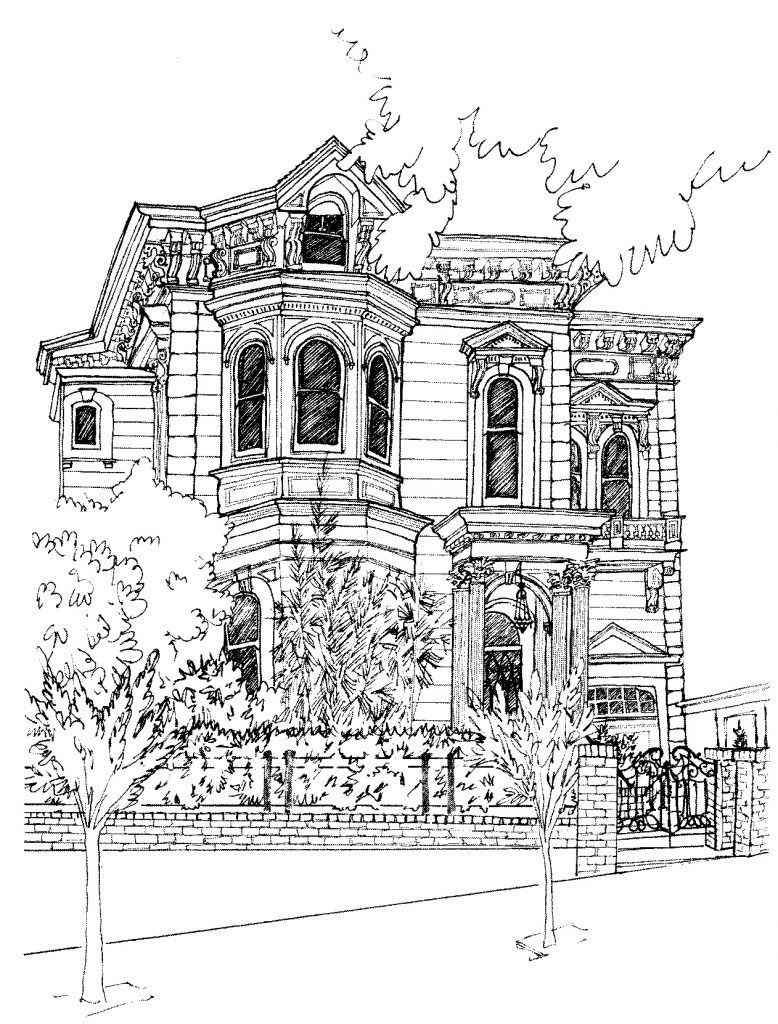LANDMARKS | ANNE BLOOMFIELD
Observe at the corner of Pine and Scott a low brick fence, a hedge and a row of cypresses. Nothing can be seen behind them except more trees and hints of a rather large white house, an excellent Italianate specimen, it develops.
No, we are not out in the country, somewhere in idyllic Sonoma County or down by old Pescadero; this is San Francisco. And house, garden and driveway, surrounded by the L-shape of Cobb School playground, comprise a real estate entity that, while now exceedingly rare, was once a standard sort of thing: a 50-vara lot.
The term comes from a Spanish measure, the vara, which is 2.75 feet long. Mexican San Francisco was surveyed — from Market Street out past 1901 Scott to Presidio Avenue — into lots 50 varas on each side, or 137.5 x 137.5 feet. Many a 19th century resident built his house on a 50-vara lot, gardening the considerable rest of his property. You see these big lots in old pictures, and here at 1901 Scott the picture, in danger one feels of going out of focus, comes alive.
The house here has lovely round-headed windows, a Corinthian-columned porch and a many-bracketed cornice around all sides. The present appearance results not only from its original design, but also from a couple of major alterations, and from wonderful preservation by the current owner, the grandson of the original owner.
Grocer and liquor dealer John Frederick Ortman, born in Hanover in 1829, bought the big lot at 1901 Scott in 1870 for $5,000. He and his family had been picnicking in the scrub-filled vicinity and took a shine to the location. Soon they were established in the house that still stands today, with a well and windmill nearby, and chickens and a cow in the area where elementary school children now play.
A photo from about 1885 shows the house with a widow’s walk on top of a flour-slope roof and no attic window. The building at that time was shallower and the front bay only one story tall. The fence was wooden pickets and the Norfolk Island pine that now towers over the corner came, in 1885, not quite up to the second floor.
With 1889 came alterations. A second story was added to the front bay and the roof shape was changed to accommodate an attic, a Queen Anne-style arch and gable appearing in the process. The house was also extended to the rear and a wrought iron fence replaced the pickets.
By 1914 Ortman had died and his son-in-law Thomas Shumate, a Missouri-born physician and pharmacist, in collaboration with designer William Merchant and his brother-contractor Christopher, put in a brick fence, walks and steps, plus a fireplace or two inside and other new hardware.
There were also stables and garages added behind the house — launching pads, so to speak, for the busy Dr. Shumate, who had a thriving medical practice as well as a string of pharmacies, the latter with their paternal druggists in near-clerical white are well remembered by present-day senior citizens of San Francisco. There was one Shumate’s at the southeast corner of Sacramento and Presidio across from the Vogue Cinema, another at the southwest corner of Fillmore and Jackson, now a coffeehouse. In fact, on the threshold of this coffeehouse one can still read: Shumate’s.
Dr. Shumate — whose son Albert was also a physician, and a wonderful historian of Californiana as well — was born in St. Louis in 1871. As a young man he came to California for his health and got a job clerking in a drugstore. Meanwhile he went to night school to get a pharmacist’s license. Then the obvious next step was to buy his own pharmacy so he could make enough money to attend medical school, tending the store at night after class.
Earning a medical degree in 1894, the first Dr. Shumate was hired on as a police department surgeon for five years. And when he married, in 1899, his father-in-law installed him and his bride in a new house on California Street in part of what is now the Cobb schoolyard. Soon he was building up his chain of pharmacies, which eventually numbered the magnificent sum of 28.
A corner in San Francisco those days was almost as likely to house a Shumate’s as a bar or restaurant. But Thomas Shumate was not content just being a physician and druggist with all those tile-floored “corner-houses.” He also ran an import-export firm and a real estate company. And then he was a police commissioner from 1912 to 1937.
He also owned Fillmore Street’s east side from Washington almost to Jackson. And he had 600 acres of orchards west of Los Altos. In Sunnyvale he owned and ran the Troy Farm Stables, the largest breeder of saddle horses in the country.
Thomas Shumate’s obituary called him “wealthy, debonair, of distinguished appearance, a notable figure in the city’s professional, political and social life.”
And in almost every detail Thomas’s son Albert matched the distinguished record — and look — of his dad.
This article first appeared in the February 1988 issue of The New Fillmore and was republished in Gables & Fables: A Portrait of San Francisco’s Pacific Heights by Anne Bloomfield and Arthur Bloomfield.
Filed under: Home & Garden, Landmarks, Neighborhood History






